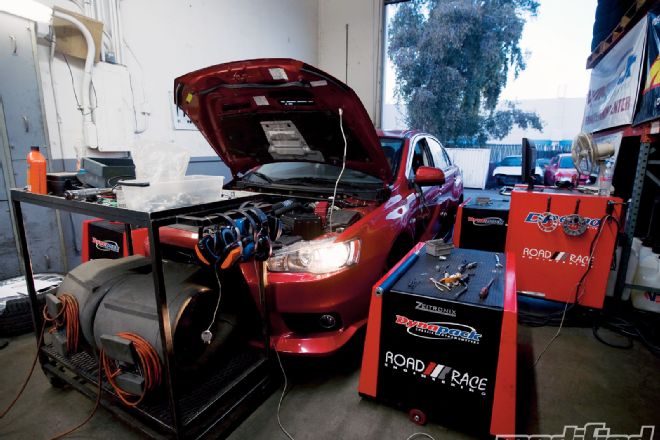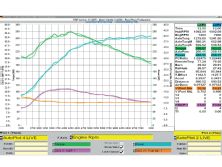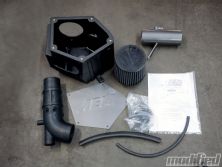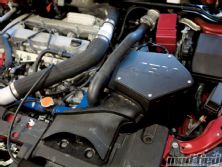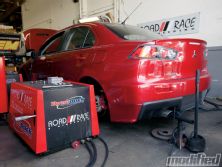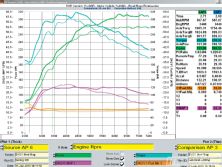Project Evolution
The EVO is one of those cars almost everyone buys knowing that they will eventually modify it. With the older-generation EVO VII and IX, you'll be hard-pressed to find a stock one for sale. Almost every one of them has some type of aftermarket part on it, but the X is a bit of a different story. Being a brand-new car on the market, owners are a bit hesitant to mod them because the chance of losing their warranty is high.
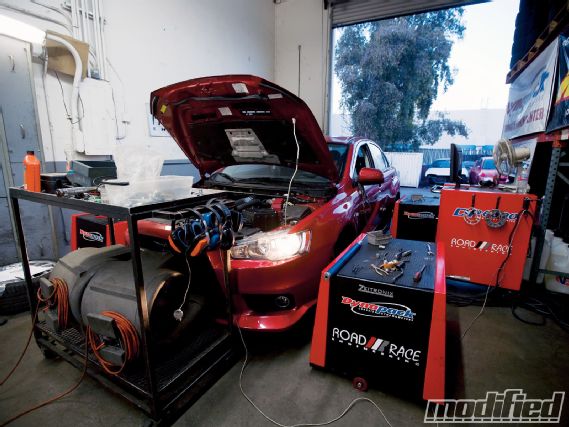 |
Evo X AEM Intake - RRE Tune
|
Evo X AEM Intake - RRE Tune
I can agree with that argument for about 10 seconds. Then I step on the pedal and a surge of 50-plus wheel horsepower over stock pushes me back into my seat, and I can't find any reason why an EVO X owner would putt around stock. It's just so easy to unlock so much power for so little money while never worrying about reliability.
The AEM intake that I installed costs approximately $280 and a reflash and dyno tune from Mike Welch at Road Race Engineering is about $500. You really can't beat that value. Other cars on the market won't pick up that kind of power even with thousands of dollars invested.
How and why it's possible for the EVO X to make such power with just an intake and retune was answered by my tuning session at RRE, and the subsequent dyno charts will explain.
After three consistent pulls, the EVO X put down a baseline of 261 whp and 277 ft-lbs of torque [1]. If you look past the numbers, you can see boost and air-fuel ratio are also plotted on the chart. Granted, it's difficult to notice variations in the orange AFR line, but you can see that it runs along the 10.0 AFR mark, which is extremely rich for a turbo car. There's a reason why, though. Running that rich provides a good safety barrier (or margin of safety), so even if the car were to lean out by a full point or two (1.0 to 2.0 AFR) it's not going to knock and blow the motor up. Secondly, Mike explained to me that the stock ECU has aggressive timing maps set from the factory, hence the need for lots of fuel and its ability to cool down the intake charge. The next interesting plot to note is boost pressure (purple line). Maximum boost peaks at 4000 rpm, hitting 22.5 psi then quickly trailing off to 14 psi by redline. As you can see, there are many areas for improvement.
The decision to go with the AEM intake was made mainly because it comes with a CARB-exempt sticker (making it a legal upgrade in California) and that other than the AEM logo on the filter box, it looks stock. Don't be fooled into thinking that because the filter isn't exposed it won't make as much power as an open element. The only difference between the two is noise. If you want the constant whooshing sound from your turbo, then an open element is for you; if you've grown tired of that noise (like me) and want a low-key setup, then a setup like the AEM intake is best.
[2] Once installed, the AEM intake (without any tuning) instantly netted an additional 20 whp and 24 ft-lbs of torque. Very nice gains, indeed, and it's across the entire rpm range. You'll notice that the boost pressure has jumped up significantly. In stock form, 4000 rpm saw 22.5 psi whereas with the intake it hit almost 25 psi and a steady gain of 2 psi was achieved throughout the rpm range.
The rise in boost pressure can be attributed to the way the vacuum lines are plumbed with the AEM intake. Also, the larger diameter of the piping results in a leaner AFR, as noted from 5000 rpm onward. These two factors are largely responsible for the increase in power and torque.
But there's another side to this story. Because we dyno'd the intake just after installing it, the ECU didn't have time to adjust the fuel trims due to the new intake, so after you drive around for a couple of days the positive cruise fuel trims go up by 10 to 12 percent. Positive fuel trims feed into the wide-open AFR calculation, meaning the leaner AFR that was noted on the dyno before will now be richer by almost a full point, which in turn reduces power output. This is exactly why you need to have your car tuned after any modification that affects fuel or airflow. Even before I was an editor at Modified, I knew of Road Race Engineering from my DSM days as experts in the 4G63 tuning world; they've done some crazy antics like flying a Galant VR4 through the air. It was only natural that a decade later I turned to a trusted resource to handle the tuning duties for my EVO X, and I wasn't disappointed.
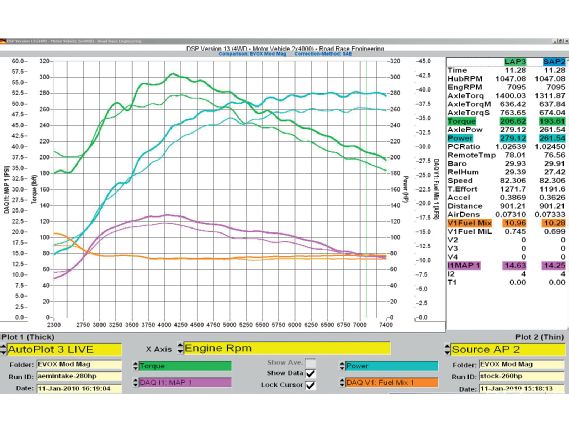 |
Evo X AEM Intake - RRE Tune
|
Evo X AEM Intake - RRE Tune
After Mike spent a few solid hours on his Dynapack AWD dyno, the tune was wrapped up and the final numbers came in at 312 whp and 318 ft-lbs of torque. A gain of 51 whp and 35 ft-lbs of torque over stock and 21 whp and 17 ft-lbs of torque over the AEM intake. At one point, a 320-whp pull was made, but with some further investigating the knock sum was rather high and it looked like the engine didn't like all that boost it was getting (24 psi) likely because of the bottleneck caused by the stock exhaust and heat-soaked stock intercooler, so Mike dialed it back to a safe and conservative level. Exactly the type of judgment call I was expecting from an experienced tuner
The final chart [3] shows the gains made from the tune versus just the AEM intake. Notice the large gaps between before and after boost and AFR. Mike was able to lean the AFR out quite a bit to a healthy level in the mid-11s while boost was actually brought down from 3500-4500 rpm due to the high knock sums experienced in that area, but it now holds steady at around 20-22.5 psi almost all the way to 6500 rpm, then tapers off at redline. It's easy to see how power is made with tuning, but the hard part is knowing how to actually do it. So leave that part to the experts.
I'll be back next month to dyno test the addition of Cobb Tuning's 3-inch turbo-back exhaust and an AMS front-mount intercooler with hard piping. If my next dyno session proves to be anything like this one, then I'm hoping for even more power to come out of the mighty 4B11.

